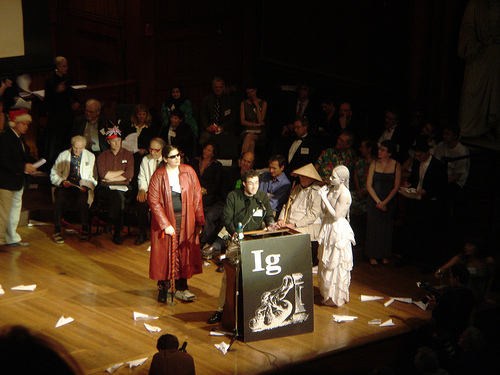An Ig Noble Cause To Celebrate

Here’s a riddle for you: what do slime molds, whale snot, and fruit bat fellatio have in common?
The 20th Annual Ig Nobel Prize ceremony.
In one of the more festive celebrations in the scientific world, the frivolous spin off of the prestigious Nobel Prize Awards presented 10 awards a week ago to scientists and researchers (dubbed “ignitaries”) who conducted the most unusual studies in 2010.
This year, the winners at the top of the docket were the scientists conducting research concerning fellatio patterns of fruit bats, the collection of whale snot and how slime molds can help predict optimal routes for railroad tracks.
Previous winners have included those who have invented bras that double as emergency protective masks, grew diamond film from tequila and invented ways to extract vanillin (vanilla flavor and scent) from cow dung.
Other research projects celebrated at the awards in the past were equally funny, such as the evidence that the presence of humans tends to sexually arouse ostriches, as well as the assertion that black holes are the physical locations of Hell.
With a tagline like “for achievements that first make people laugh, then make them think,” it’s hard to miss the light-hearted nature of the awards.
The name, “Ig Nobel,” (pronounced IG-NO-BELL) is a play off of Nobel, the last name of the talented chemist and inventor who donated about $250 million to help award prizes to scientists who progress and advance science for the good of many.
The word “ignoble” means lowly, base, or simple, which is the teasing part of the ceremonies.
The award was established in 1991 by the Annals of Improbable Research (AIR), a science magazine geared towards humorous aspects of the scientific world.
The awards are intended to be a parody of the Nobel Prize, but actual Nobel laureates present the awards at the ceremony, which many people fly from all around the world to attend, on their own dime.
Occasionally, the awards are meant to gently mock or satirize events, such as the award given for “science education” to the Kansas and Colorado state school boards over their decision to include the teaching of creationism in the science classroom.
However, several studies recognized here have had an impact.
Research conducted in 2006 suggested that human feet and Limburger cheese have similar appeal to the mosquitoes carrying malaria, a finding which has changed how and with what mosquito traps are set. Scientists plan to use the fatty acids on the cheese that emit the smell similar to human feet to attract the pesky malaria vectors.
So it’s not all fun and games. Many awardees do take the honor seriously. But the event still has an atmosphere of levity.
The event is usually closed with traditional words of well-wishing: “If you didn't win a prize — and especially if you did — better luck next year!”
And so we wait for another year of unusual studies.
To reach reporter Lindy Tolbert, click here.



